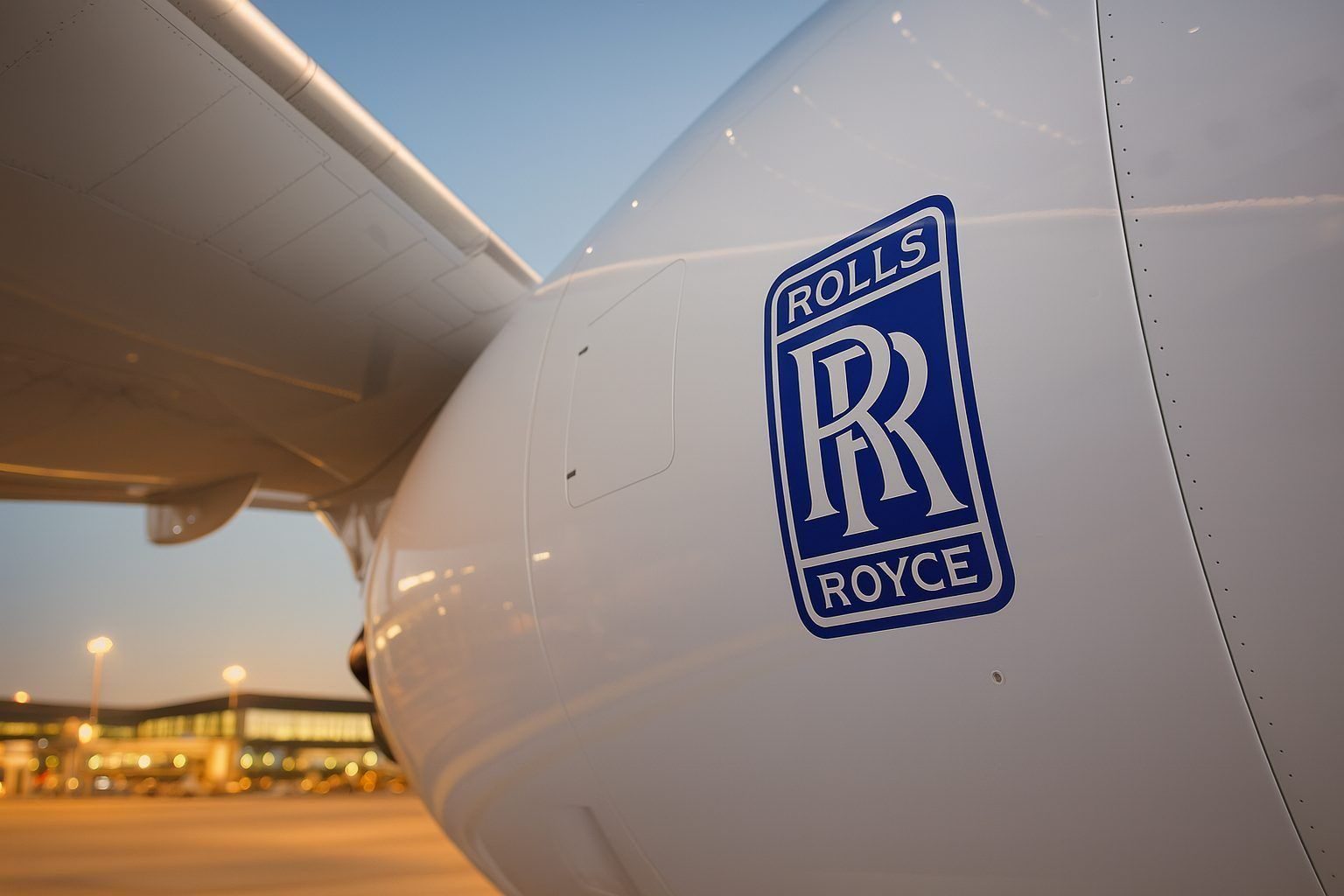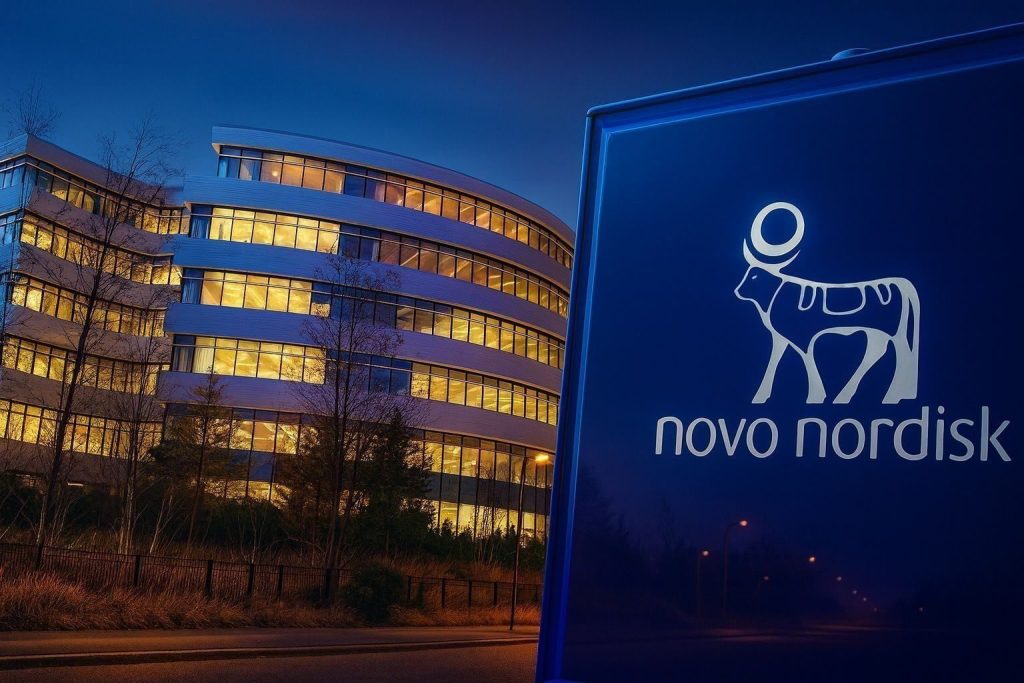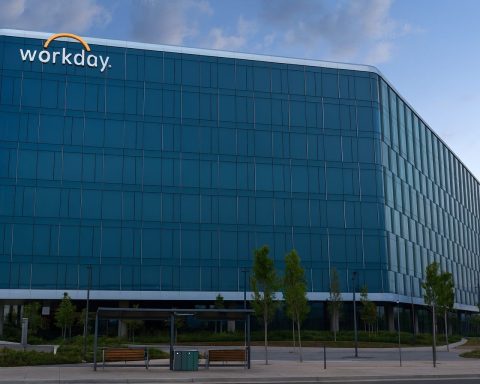Rolls-Royce Holdings plc (LON: RR.) spent Friday trading as one of the FTSE 100’s bright spots, with the share price hovering above 1,060p and extending its rebound from this week’s lows. As of around 15:00 GMT, Rolls-Royce shares were changing hands near 1,076p, up roughly 1.6% on the day and among the top blue-chip risers. [1]
At the same time, a flurry of fresh news on 28 November – from a quantum-computing milestone to new attention on the Trent 7000 engine and broader A330neo demand – reinforced the long‑term growth story that has already driven a spectacular multi‑year recovery in the stock. [2]
Rolls-Royce share price today: RR.L in the 1,060p–1,080p band
Market data from several major platforms show Rolls-Royce trading firmly in positive territory on Friday:
- Latest trading level: Investing.com quotes Rolls-Royce at about 1,064.5p in afternoon dealing, with an intraday range between 1,060.5p and 1,078.0p. [3]
- FTSE 100 riser: Sharecast lists Rolls-Royce at 1,076.0p, up 1.65%, placing it at the top of the FTSE 100 risers board around 15:00 GMT and noting that the stock is in its fourth straight up session after hitting a three‑month low on Monday. [4]
- Previous close: Most data providers show a Thursday close of 1,058.5p, meaning today’s move is roughly a 0.5–1.5% gain, depending on the exact timestamp. [5]
In other words, RR.L is modestly higher on the day but still trading near record territory, reflecting how much of the turnaround story is already in the price.
Intraday snapshot and trading interest
Today’s trading fits into a pattern of heavy interest in Rolls-Royce among UK investors:
- Intraday range: So far, the stock has stayed within a relatively tight band of about 1,060–1,078p, suggesting consolidation after a volatile November in which daily moves of 30–40p were common. [6]
- Liquidity and retail interest: A “Daily Trading Flash” from interactive investor ranks Rolls-Royce among the 10 most‑traded shares on its platform this morning, with around 63% of trades on the buy side – a sign that retail investors remain net buyers at current levels. [7]
- Technical backdrop: Quantitative service StockInvest notes that, while the short‑term moving average still points to upside, the longer‑term trend remains more cautious, generating an overall “sell” or “weak hold” style signal in some of its models. [8]
For traders, that mix – strong momentum, heavy retail interest, but some stretched technicals – helps explain why the share price is oscillating near its recent highs rather than breaking decisively to a new peak.
One-year performance: from deep value to market darling
Rolls-Royce’s share price today only makes sense in the context of its huge recovery:
- 12‑month move: Investing.com data show the stock up around 90% over the past year, with a 52‑week range of roughly 542p to 1,195p. [9]
- Year to date: The Armchair Trader notes that for the second year running Rolls-Royce has been among the FTSE 100’s top performers, with the shares up about 80% in 2025 alone. [10]
- Multi‑year gains: Long‑term coverage from outlets such as The Guardian and Reuters highlights that the stock has risen several hundred percent in the last two years and delivered a multi‑bagger return since the depths of the pandemic. [11]
For investors who bought during the crisis years, Rolls-Royce has shifted from a distressed turnaround to a core FTSE 100 growth name whose market value now sits among the index heavyweights. [12]
Today’s big news: a quantum leap in jet engine design
The headline corporate news on 28 November 2025 comes from Rolls-Royce’s own media centre, where the company unveiled a quantum‑computing breakthrough in partnership with Xanadu and Riverlane. [13]
What Rolls-Royce announced
- Rolls-Royce, working with Canadian quantum specialist Xanadu and UK‑based Riverlane, has demonstrated that complex airflow simulations used to design jet‑engine components can be dramatically accelerated using quantum algorithms. [14]
- By integrating Rolls-Royce’s computational fluid dynamics (CFD) test cases into Xanadu’s PennyLane softwareand Riverlane’s error‑corrected quantum algorithms, the team showed how run times could be shrunk from weeks to under an hour on future fault‑tolerant quantum hardware. [15]
This doesn’t alter near‑term profits, but it reinforces a key part of the Rolls-Royce investment story: the company is betting heavily on advanced digital tools – from AI to quantum computing – to cut design times, improve engine performance and support long‑term margins.
For the market, today’s quantum announcement adds another “innovation” layer to a story that has mostly been about cost‑cutting, price discipline and recovering engine flying hours.
Spotlight on Trent 7000: next‑generation benefits and A330neo demand
Also dated 28 November, Rolls-Royce and syndicated outlets such as MarketScreener are highlighting a new piece on the Trent 7000, the engine family that powers the Airbus A330neo. [16]
Key messages from that material:
- The Trent 7000 is positioned as the “ultimate time machine” for airlines, with routine maintenance cut by around 60% versus the earlier Trent 700 – itself an industry benchmark. [17]
- Reduced maintenance translates into more time on wing, fewer disruptions and better fleet utilisation, which directly affects the profitability of A330neo operators. [18]
Those marketing points landed on the same day as fresh airline fleet news out of the Middle East:
- An article in Machinery Market reports that Etihad Airways has placed a firm order for six Airbus A330‑900 jets and plans to lease nine more, all powered by Rolls-Royce Trent 7000 engines. [19]
For shareholders, the Trent 7000 messaging and Etihad’s fleet plans reinforce a simple theme: wide‑body demand remains robust, and Rolls-Royce engines are embedded at the heart of that growth.
New EASA directive: Trent 7000 inspections underline ongoing risk
Not all of today’s headlines are unambiguously positive. The European Union Aviation Safety Agency (EASA) has issued a new Airworthiness Directive, 2025‑0266, dated 28 November, covering high‑pressure turbine blade inspections on Trent 7000 engines. [20]
- The directive, which becomes effective on 12 December 2025, supersedes an earlier AD from January and mandates additional inspection procedures linked to Rolls-Royce alert service bulletins. [21]
Airworthiness directives are a normal feature of the aerospace industry and don’t necessarily imply a new crisis. However, they highlight the technological and regulatory risk that investors still have to price into Rolls-Royce – especially for newer engine variants where durability expectations are being pushed hard.
Recent catalysts still driving sentiment in the background
Today’s price action also sits on top of several recent, market‑moving catalysts from earlier in November and this year.
1. Trading update: guidance reaffirmed, nuclear ambitions intact
On 13 November, Rolls-Royce delivered a confident trading update, covered in depth by interactive investor: [22]
- Management reaffirmed 2025 underlying operating profit guidance of £3.1–3.2bn, alongside similarly strong free‑cash‑flow targets.
- Civil aerospace remains the main growth engine, with wide‑body flying hours for the first ten months of 2025 up about 8% year‑on‑year to 109% of 2019 levels – a key driver of service revenues. [23]
- The company highlighted robust order intake in its Power Systems business (notably for data‑centre generation) and continued strength in Defence. [24]
- Rolls-Royce also reiterated its enthusiasm for small modular reactors (SMRs), noting progress in the UK (through Great British Energy‑Nuclear) and steps into the US regulatory process. [25]
That update reassured the market that the mid‑term transformation remains on track, even as the share price had started to plateau following a record run.
2. Credit rating upgrades: back into the investment‑grade club
Credit‑rating agencies have turned materially more positive on Rolls-Royce in 2025:
- Fitch Ratings upgraded Rolls-Royce plc’s Long‑Term Issuer Default Rating to ‘BBB+’ with a Positive Outlookin March, citing a significantly improved financial profile, stronger margins and healthier free cash flow. [26]
- On 20 November, Moody’s followed by lifting Rolls-Royce’s rating to Baa1 from Baa2, also with a positive outlook, pointing to “continued very strong performance” and broad‑based growth prospects. [27]
Stronger ratings lower financing costs, widen the pool of potential bond investors and reinforce the message that Rolls-Royce is no longer the highly leveraged recovery story it was a few years ago.
3. Emirates and Dubai Airshow momentum
On 20 November, Reuters reported that Emirates had agreed a deal with Rolls-Royce allowing the airline to perform maintenance, repair and overhaul on its own Trent 900 engines for the Airbus A380 fleet from 2027. [28]
Combined with the Etihad A330neo order and broader Dubai Airshow announcements, these deals:
- Lock in long‑term service revenues for Rolls-Royce via maintenance and parts; and
- Underscore the continuing commitment of Gulf carriers to large, Rolls‑powered wide‑bodies even as newer aircraft models enter the market. [29]
Fundamentals: from crisis stock to cash generator
Behind today’s share price, the fundamental turnaround remains the core of the bull case.
- Reuters and The Guardian both note that half‑year 2025 underlying operating profit rose to around £1.7bn, with margins above 19%, prompting Rolls-Royce to raise full‑year guidance for both profit and free cash flow to about £3.2bn and £3.1bn respectively. [30]
- Strong performance has allowed the company to reinstate dividends and launch a £1bn share buyback, taking total shareholder returns in 2025 close to £1.9bn, according to interactive investor. [31]
- Civil aerospace growth has been complemented by booming demand for power systems for AI data centres and steady Defence orders, particularly in submarine reactors and other long‑dated programmes. [32]
That combination has led many analysts to reframe Rolls-Royce as a structural growth and cash‑flow story, rather than a simple cyclical recovery play.
Analyst sentiment and valuation
Analyst and quant views remain broadly favourable, but there are signs of valuation tension:
- Consensus rating: MarketScreener lists around 18 analysts covering Rolls-Royce with an average opinion of “Buy” and a 12‑month target price near 1,190–1,200p, roughly 10–15% above Thursday’s close. [33]
- RBC’s stance: Reporting via Proactive indicates that RBC Capital Markets recently initiated coverage with an “Outperform” rating, arguing there is “more fuel in the tank” even after an 80‑plus percent year‑to‑date rise. [34]
- Valuation metrics: Depending on which data provider and profit measure you use, Rolls-Royce trades on a mid‑teens to high‑multiple P/E, with a modest dividend yield of around 0.6–0.7% – rich versus many FTSE 100 industrials but not extreme compared to global defence and aerospace peers. [35]
On the other side of the debate, recent commentary from outlets like Motley Fool UK questions whether the “risks are rocketing” after such a strong run, suggesting that expectations for future earnings now leave less room for error. [36]
Key risks investors are weighing
Even on a strong day like today, several risks remain front of mind for investors in RR.L:
- Execution risk
Consensus earnings forecasts now sit near or above management guidance in some cases. Any disappointment on engine durability, cash conversion or SMR timelines could trigger a sharp de‑rating. [37] - Cyclical exposure
Civil aerospace revenue depends on long‑haul air traffic and airline capex. A global slowdown, shock to fuel prices or renewed travel restrictions would likely hit flying‑hour growth and, by extension, high‑margin service income. [38] - Geopolitics and defence budgets
Defence is a key profit driver but remains subject to political decisions and peace‑dividend cycles. Recent market moves have shown that talk of potential peace deals can push defence names lower on individual days. [39] - Technical and regulatory risk
The new EASA Trent 7000 directive and the history of airworthiness bulletins around certain Trent variants underline that Rolls-Royce must keep delivering on promised improvements in time‑on‑wing and reliability. [40] - Valuation and sentiment
After a multi‑year rally and a huge re‑rating, the share price is now close to average broker targets, and short‑term technical models are more cautious. That makes the stock more vulnerable to sentiment swings and negative surprises. [41]
What today’s move means for existing and prospective investors
Put together, 28 November 2025 is another day that showcases the two faces of the Rolls-Royce investment case:
- On the plus side, the share price is higher again, supported by:
- A quantum‑computing breakthrough that underlines Rolls-Royce’s push into advanced engineering tools; [42]
- Positive narrative around Trent 7000 and fresh A330neo demand from carriers like Etihad; [43]
- Strong underlying earnings, cash generation and credit‑rating momentum, plus continuing interest from both institutional brokers and retail traders. [44]
- On the risk side, today’s EASA directive and the sheer scale of the recent rally are reminders that:
- Engineering excellence has to be maintained, not just achieved once; and
- At current levels, Rolls-Royce is priced as a high‑quality, structurally growing franchise, leaving less room for operational mis‑steps than in the past. [45]
For anyone following RR.L, the story on 28 November 2025 is less about a one‑day pop and more about whether Rolls-Royce can keep beating already elevated expectations over the next several years – in engine performance, in digital innovation, and in turning its vast installed base into reliable, compounding cash flow.
This article is for information only and does not constitute investment advice. Always do your own research or consult a regulated financial adviser before making investment decisions.
References
1. www.sharecast.com, 2. www.rolls-royce.com, 3. www.investing.com, 4. www.sharecast.com, 5. stockinvest.us, 6. www.investing.com, 7. www.ii.co.uk, 8. stockinvest.us, 9. www.investing.com, 10. www.thearmchairtrader.com, 11. www.reuters.com, 12. www.theguardian.com, 13. www.rolls-royce.com, 14. www.rolls-royce.com, 15. www.rolls-royce.com, 16. www.marketscreener.com, 17. www.marketscreener.com, 18. www.marketscreener.com, 19. www.machinery-market.co.uk, 20. ad.easa.europa.eu, 21. ad.easa.europa.eu, 22. www.ii.co.uk, 23. www.ii.co.uk, 24. www.ii.co.uk, 25. www.ii.co.uk, 26. www.fitchratings.com, 27. www.investing.com, 28. www.reuters.com, 29. www.machinery-market.co.uk, 30. www.reuters.com, 31. www.ii.co.uk, 32. www.theguardian.com, 33. www.marketscreener.com, 34. www.proactiveinvestors.co.uk, 35. www.thearmchairtrader.com, 36. www.fool.co.uk, 37. www.ii.co.uk, 38. www.theguardian.com, 39. stockinvest.us, 40. ad.easa.europa.eu, 41. stockinvest.us, 42. www.rolls-royce.com, 43. www.machinery-market.co.uk, 44. www.fitchratings.com, 45. ad.easa.europa.eu










